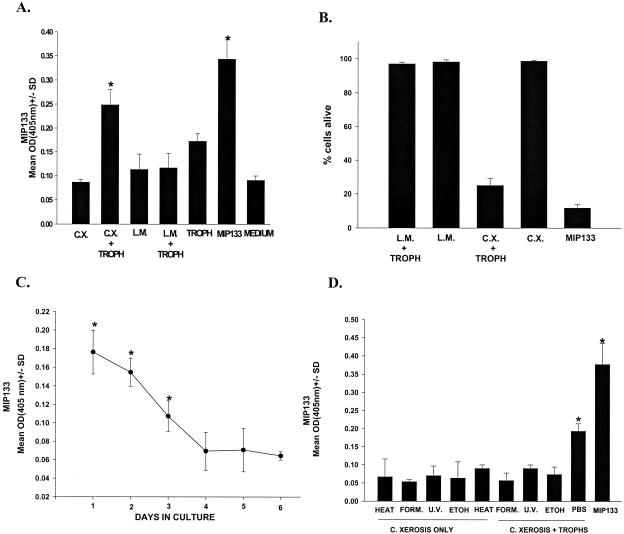FIG. 4.
Induction of MIP133 synthesis by C. xerosis. (A) MIP133 production was induced by incubating A. castellanii trophozoites (1 × 106 cells/ml) with C. xerosis or L. monocytogenes at a concentration of 5 × 106 cells/ml for 72 h in PYG medium in vitro. Trophozoites without bacteria or bacteria alone (medium) served as controls. The supernatants were collected, and the MIP133 production was measured by the ELISA. (B) Supernatants were also tested for the capacity to produce cytopathic effects on human corneal epithelial cell monolayers. Bacteria (5 × 106 cells/ml) were either cultured alone or cultured with Acanthamoeba trophozoites (1 × 106 cells/ml) in PYG medium for 3 days, the supernatants were collected, and the MIP133 production was measured by the ELISA. The MIP133 cytolytic protein (15.6 μg of protein in 25 μl of PBS) was added to 96-well plates with confluent monolayers of human corneal epithelial cells. The cytopathic effects of the MIP133 protein were assessed by spectrophotometric analysis of Giemsa-stained corneal epithelial cell monolayers after 24 h of exposure to the MIP133 protein as described in Materials and Methods. (C) Kinetics of MIP133 production. Acanthamoeba trophozoites were cocultured with bacteria for 72 h, and then the cultures were treated with antibiotics (0.7 mg of penicillin/ml and 1.04 mg of streptomycin/ml) to kill extracellular bacteria. Axenic cultures of trophozoites were washed extensively and cultured without mannose, and MIP133 was measured by the ELISA for 5 days. (D) Production of MIP133 in the presence of viable and nonviable C. xerosis was assessed by culturing amoebae with viable C. xerosis or C. xerosis treated with 70% ethanol, heat (56°C), 4% formalin, or 800 mJ of UV irradiation/cm2. Supernatants were collected 3 days later, and MIP133 was measured by the ELISA. Purified MIP133 (15.6 μg/200 μl) was used as a positive control. An asterisk indicates that a result is significantly different from the result for the PBS control (P < 0.05). Abbreviations: OD(405nm), optical density at 405 nm; C.X., C. xerosis; L.M. L. monocytogenes; TROPH, trophozoites; FORM., formalin; U.V., UV irradiation; ETOH, ethanol.

